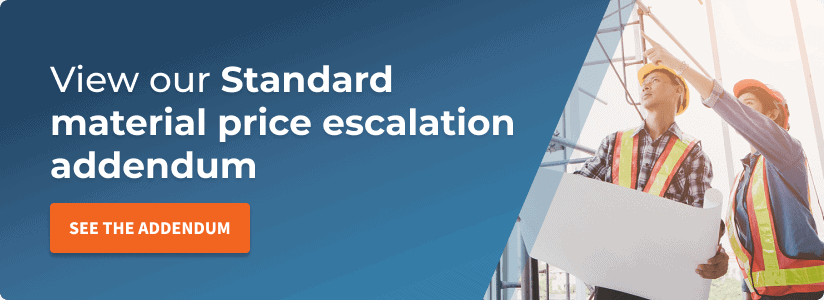Material price escalation spikes and supply shortages threaten builders’ financial viability in today’s construction market. ConsensusDocs, the leader in standard construction contracts, has compiled resources below to address price escalation. The best approach is to include price escalation provision, such as the ConsensusDocs 200.1 Material Price Escalation Amendment in your construction agreement at contract signing.
A material price escalation clause adjusts the contract price based upon a certain metric, usually an objective index. Existing contracts that do not contain a price escalation provision can utilize a price escalation amendment if both parties agree. Choosing a reliable material price index that specifically and accurately addresses the prices involved on a particular project is one of the more difficult aspects of drafting a price escalation clause and the below resources now include some indexes that are available for construction.
Owners, Constructors, General Contractors, Subcontractors alike should consider price escalation/de-escalation clauses in these uncertainty times. ConsensusDocs is the only publisher of a standard price escalation clause. The ConsensusDocs 200.1 Standard Time and Price Impacted Materials Addendum and Schedule A is available on all paid subscriptions. Rather than guessing to price out cost fluctuations, owners and builders would be wise to consider a best practice price escalation clause that is tied to an objective index agreed upon ahead of time, that allow prices to go up, or down. Hope and a contingency fund don’t qualify as a risk management strategy.
Typically, constructors, subcontractors, and materials suppliers typically bear the risk for cost increases in a firm-fixed or lump sum agreement, even if such increases are unforeseen and not their fault. However, supply shortages, could give rise for excusable performance delay, but paying higher costs for material supplies are usually considered a business risk. Some additional mitigation strategies, include limiting the amount of time a bid can be relied upon; using cost of the work agreements (i.e. ConsensusDocs 230 or 500) rather than lump sum agreements (i.e. ConsensusDocs 205 or 751); breaking projects into phases; providing allowances or alternates for materials; early procurement and storage of materials (see the ConsensusDocs 750.1 Storage Rider); prefabrication (see ConsensusDocs 753 Prefab agreement); or increasing contingency amounts to allow for material price increases.
Examples of Cost indexes
- ENR Historical Indices
- DCD Cost Escalation Index Table & Regional Cost Modifers
- Turner Cost Index
- Mortenson Overall Construction Cost Index Q2 2022
- RS Means City Cost Index - 2019
Federal Resources
- Federal Acquisition Regulations Economic Price Adjustment-Labor and Material
- Code of Federal Regulations Economic Price Adjustment - Fuel Surcharge
State-Level Resources
Arizona
Nevada
Ohio
- Ohio DOT Contract Esclation Clause Covering Fuel - 2018 for 2019
- Ohio DOT Contract Esclation Clause Covering Steel - 2018 for 2019
- Ohio DOT Contract Esclation Clause Covering Asphalt - 2018 for 2019
- Ohio DOT Contract Esclation Clause Covering Cement - 2018 for 2019
West Virginia
Articles & Other Information
- Pricing insanity: Material costs escalate, driving contractor desperation
- De-escalating The Impact of Price Escalation
- Tariffs, Taxes, and Trade Wars: Using Material Price Escalation Clauses to Mitigate Risk in an Uncertain Political Climate
- Negotiating Material Escalation Clauses
- AGC's Construction Inflation Alert - September 2021
- Mitigating the Effect of Construction Price Escalations
- Addressing Material Prices
- The Price Isn’t Right: Don’t Get Escalated Out of Business
- Recovery of Material Escalation Costs Arising from Steel and Aluminum Tariffs
Multimedia
AGC of America's ConstructorCast - Material Price Escalation, Delays, and COVID-19 Podcast Episode

